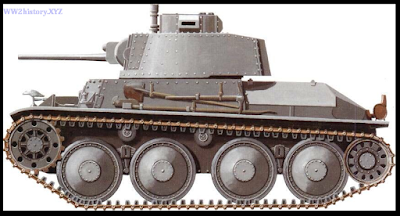In 1937 the international situation was rapidly deteriorating, so the Czech army issued a requirement for a new light tank. This time the army was determined that the troubles encountered with the LT vz 35 light tank when it entered service, resulting from a lack of testing, would not be repeated. Skoda entered its S-ll-a and S-ll-b, while CKD entered an LT vz 35 with the engine and transmission of the TNH tank, the LTL, the TNH P-S (already produced for export) as well as a new medium tank called the V-8- H. During the extensive trials the TNH P-S was found to be the best design and on 1 July 1938 was adopted as the standard light tank of the Czech army under the designation LT vz 38, but none had entered service at the time of the German occupation in 1939. The vehicle remained in production for the German army between 1939 and 1942, more than 1,400 being built under the designation Panzerkampfwagen 38(t)
 |
| Used by two Panzer Divisions in 1940, the PzKpfw 38(t) was in production for the German army until 1942. The basic chassis was later used for a number of SP artillery conversions. |
Ausf S to PzKpfw 38(t) Ausf G. (Aus- führung is the German word for model or mark.) The Germans also exported 69 vehicles to Slovakia, 102 to Hungary, 50 to Romania and 10 to Bulgaria. Dur- ing the invasion of France the tank was used by the 7th and 8th Panzer Divisions, and continued in service as a light tank until 1941-2.
The hull and turret of the vehicle were of riveted construction, the top of the superstructure being bolted into position, Minimum armour thickness was 10 mm (0.4 in) and maximum thickness 25 mm (1 in), although from the Ausf E this was increased to 50 mm (1.96 in). The driver was seated at the front of the tank on the right, with the bow machine-gunner to his left and operating the 7.92-mm (0,31-in) MG 37(t) machine-gun. The two-man turret was in the center of the hull and armed with a 37.2-mm Skoda A7 gun, which could fire both armour-piercing and HE rounds with an elevation of +12° and a depression of -6°. Mounted co- axial with and to the right of the main armament was another 7.92-mm (0,31- in) machine-gun. Totals of 90 rounds of 37-mm and 2,550-rounds of machine- gun ammunition were carried. The engine was at the rear of the hull and coupled to a transmission with one re- verse and five forward gears. Suspension on each side consisted of four large rubber tyred road wheels suspended in pairs on leaf springs, with the drive sprocket at the front and idler at the rear, and with two track-return rollers.
 |
| A PzKpfw 38(t) during the invasion of France; the 7th and 8th Panzer Divisions used the tank. The commander of the 7th Division became well known later in the war his name was Rommel. |
When outclassed as a tank the PzKpfw 38(t) was widely used as a reconnaissance vehicle, and the Ger- mans even fitted some chassis with the turret of the SdKfz 222 light armoured car complete with its 20-mm cannon. The chassis of the light tank was also used as the basis for a large number of vehicles including the Marder tank destroyer, which was fitted with a new superstructure armed with 75-mm (2.95-in) anti-tank gun, various self- propelled 15-cm (5.9-in) guns, a 20-mm self-propelled anti-aircraft gun, several types of weapons carriers and the Hetzer tank destroyer, to name just a few. The last was armed with a 75-mm (2.95-in) gun in a fully enclosed fighting compartment with limited traverse, and was considered by many to be one of the best vehicles of its type during World War II. A total of 2,584 was built between 1944 and 1945, and production continued after the war for the Czech army, a further 158 being sold to Switzerland in 1946-7 under the designation G-13. These were finally withdrawn from service in the late 1960.
Specification TNH P-S Light Tank
TNHP-S Crew : 4
Weight: 9700 kg (21,385 lb)
Dimensions:
Length 4.546 m ( 14 ft 11 in)
Width 2.133 m (7 ft 0 in)
Height 2,311 m (7 ft 7 in)
Powerplant :one Praga EPA six-cylinder water cooled inline petrol engine developing 150 hp (112 kW).
Performance:
Maximum road speed 42 km/h (26 mph).
Maximum range 200 km (125 miles).
Fording 0.9 m (3 ft).
Gradient 60 per cent.
Vertical obstacle 0.787 m (2 ft 7 in).
Trench 1.879 m (6 ft 2 in).
